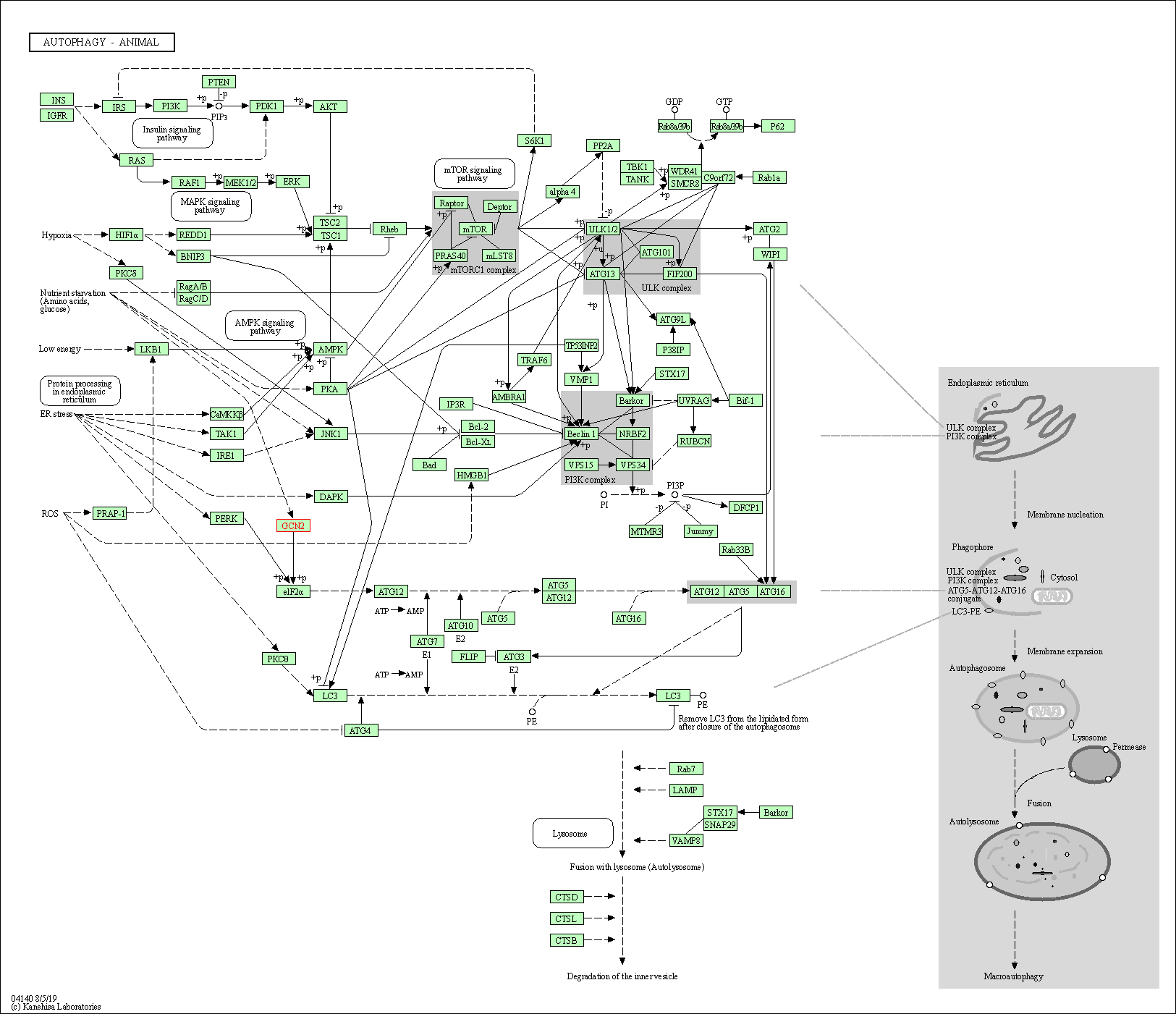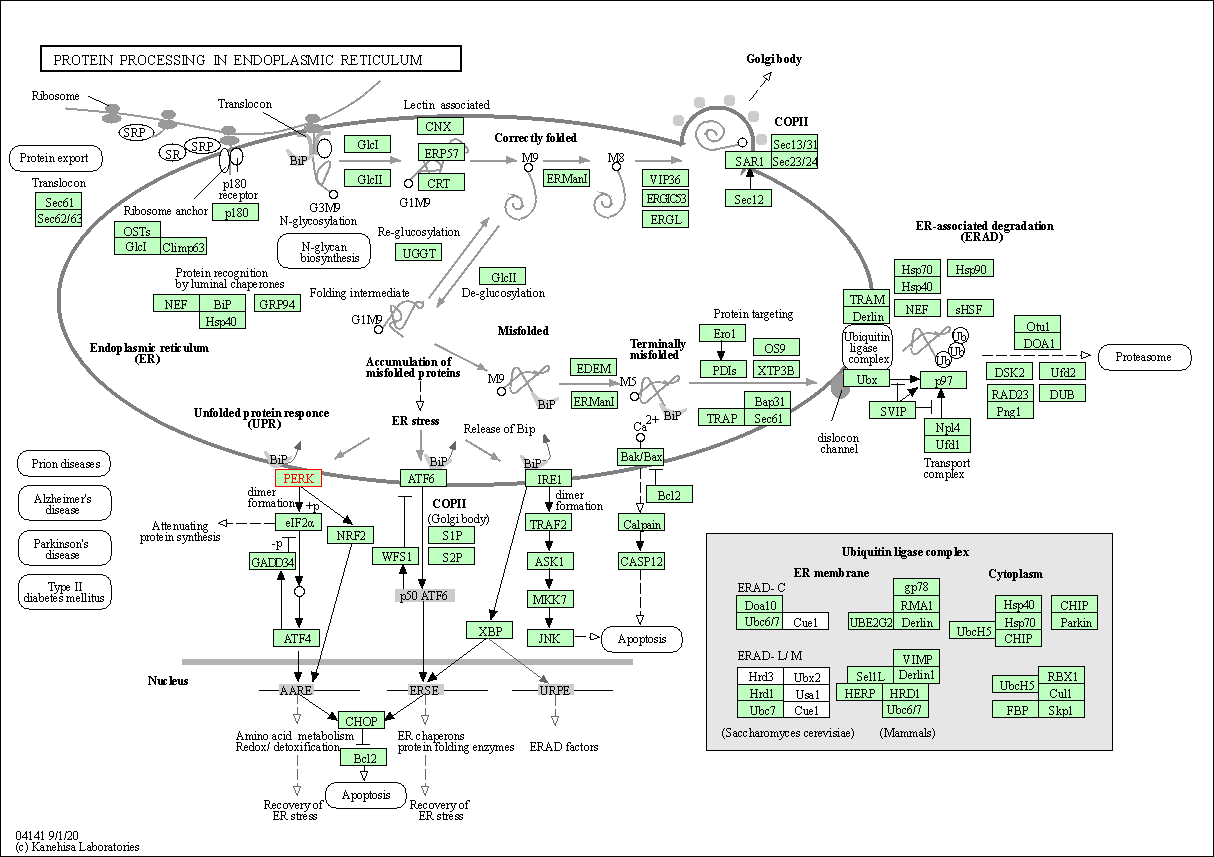Target Information
| Target General Information | Top | |||||
|---|---|---|---|---|---|---|
| Target ID |
T66396
(Former ID: TTDI03187)
|
|||||
| Target Name |
Eukaryotic translation initiation factor 2-alpha kinase 4 (EIF2AK4)
|
|||||
| Synonyms |
eIF-2-alpha kinase GCN2; KIAA1338; GCN2-like protein; GCN2
Click to Show/Hide
|
|||||
| Gene Name |
EIF2AK4
|
|||||
| Target Type |
Literature-reported target
|
[1] | ||||
| Function |
Metabolic-stress sensing protein kinase that phosphorylates the alpha subunit of eukaryotic translation initiation factor 2 (eIF-2-alpha/EIF2S1) on 'Ser-52' in response to low amino acid availability. Plays a role as an activator of the integrated stress response (ISR) required for adapatation to amino acid starvation. Converts phosphorylated eIF-2-alpha/EIF2S1 either to a competitive inhibitor of the translation initiation factor eIF-2B, leading to a global protein synthesis repression, and thus to a reduced overall utilization of amino acids, or to a translational initiation activation of specific mRNAs, such as the transcriptional activator ATF4, and hence allowing ATF4-mediated reprogramming of amino acid biosynthetic gene expression to alleviate nutrient depletion. Binds uncharged tRNAs (By similarity). Involved in cell cycle arrest by promoting cyclin D1 mRNA translation repression after the unfolded protein response pathway (UPR) activation or cell cycle inhibitor CDKN1A/p21 mRNA translation activation in response to amino acid deprivation. Plays a role in the consolidation of synaptic plasticity, learning as well as formation of long-term memory. Plays a role in neurite outgrowth inhibition. Plays a proapoptotic role in response to glucose deprivation. Promotes global cellular protein synthesis repression in response to UV irradiation independently of the stress-activated protein kinase/c-Jun N-terminal kinase (SAPK/JNK) and p38 MAPK signaling pathways (By similarity). Plays a role in the antiviral response against alphavirus infection; impairs early viral mRNA translation of the incoming genomic virus RNA, thus preventing alphavirus replication (By similarity).
Click to Show/Hide
|
|||||
| UniProt ID | ||||||
| EC Number |
EC 2.7.11.1
|
|||||
| Sequence |
MAGGRGAPGRGRDEPPESYPQRQDHELQALEAIYGADFQDLRPDACGPVKEPPEINLVLY
PQGLTGEEVYVKVDLRVKCPPTYPDVVPEIELKNAKGLSNESVNLLKSRLEELAKKHCGE VMIFELAYHVQSFLSEHNKPPPKSFHEEMLERRAQEEQQRLLEAKRKEEQEQREILHEIQ RRKEEIKEEKKRKEMAKQERLEIASLSNQDHTSKKDPGGHRTAAILHGGSPDFVGNGKHR ANSSGRSRRERQYSVCNSEDSPGSCEILYFNMGSPDQLMVHKGKCIGSDEQLGKLVYNAL ETATGGFVLLYEWVLQWQKKMGPFLTSQEKEKIDKCKKQIQGTETEFNSLVKLSHPNVVR YLAMNLKEQDDSIVVDILVEHISGVSLAAHLSHSGPIPVHQLRRYTAQLLSGLDYLHSNS VVHKVLSASNVLVDAEGTVKITDYSISKRLADICKEDVFEQTRVRFSDNALPYKTGKKGD VWRLGLLLLSLSQGQECGEYPVTIPSDLPADFQDFLKKCVCLDDKERWSPQQLLKHSFIN PQPKMPLVEQSPEDSEGQDYVETVIPSNRLPSAAFFSETQRQFSRYFIEFEELQLLGKGA FGAVIKVQNKLDGCCYAVKRIPINPASRQFRRIKGEVTLLSRLHHENIVRYYNAWIERHE RPAGPGTPPPDSGPLAKDDRAARGQPASDTDGLDSVEAAAPPPILSSSVEWSTSGERSAS ARFPATGPGSSDDEDDDEDEHGGVFSQSFLPASDSESDIIFDNEDENSKSQNQDEDCNEK NGCHESEPSVTTEAVHYLYIQMEYCEKSTLRDTIDQGLYRDTVRLWRLFREILDGLAYIH EKGMIHRDLKPVNIFLDSDDHVKIGDFGLATDHLAFSADSKQDDQTGDLIKSDPSGHLTG MVGTALYVSPEVQGSTKSAYNQKVDLFSLGIIFFEMSYHPMVTASERIFVLNQLRDPTSP KFPEDFDDGEHAKQKSVISWLLNHDPAKRPTATELLKSELLPPPQMEESELHEVLHHTLT NVDGKAYRTMMAQIFSQRISPAIDYTYDSDILKGNFSIRTAKMQQHVCETIIRIFKRHGA VQLCTPLLLPRNRQIYEHNEAALFMDHSGMLVMLPFDLRIPFARYVARNNILNLKRYCIE RVFRPRKLDRFHPKELLECAFDIVTSTTNSFLPTAEIIYTIYEIIQEFPALQERNYSIYL NHTMLLKAILLHCGIPEDKLSQVYIILYDAVTEKLTRREVEAKFCNLSLSSNSLCRLYKF IEQKGDLQDLMPTINSLIKQKTGIAQLVKYGLKDLEEVVGLLKKLGIKLQVLINLGLVYK VQQHNGIIFQFVAFIKRRQRAVPEILAAGGRYDLLIPQFRGPQALGPVPTAIGVSIAIDK ISAAVLNMEESVTISSCDLLVVSVGQMSMSRAINLTQKLWTAGITAEIMYDWSQSQEELQ EYCRHHEITYVALVSDKEGSHVKVKSFEKERQTEKRVLETELVDHVLQKLRTKVTDERNG REASDNLAVQNLKGSFSNASGLFEIHGATVVPIVSVLAPEKLSASTRRRYETQVQTRLQT SLANLHQKSSEIEILAVDLPKETILQFLSLEWDADEQAFNTTVKQLLSRLPKQRYLKLVC DEIYNIKVEKKVSVLFLYSYRDDYYRILF Click to Show/Hide
|
|||||
| 3D Structure | Click to Show 3D Structure of This Target | AlphaFold | ||||
| Cell-based Target Expression Variations | Top | |||||
|---|---|---|---|---|---|---|
| Cell-based Target Expression Variations | ||||||
| Drug Binding Sites of Target | Top | |||||
|---|---|---|---|---|---|---|
| Ligand Name: TKI258 | Ligand Info | |||||
| Structure Description | GCN2 (EIF2ALPHA KINASE 4, E2AK4) IN COMPLEX WITH COMPOUND 1 (dovitinib) | PDB:7QQ6 | ||||
| Method | X-ray diffraction | Resolution | 2.80 Å | Mutation | Yes | [2] |
| PDB Sequence |
SRYFIEFEEL
593 QLLGKGAFGA603 VIKVQNKLDG613 CCYAVKRIPI623 NPASRQFRRI633 KGEVTLLSRL 643 HHENIVRYYN653 AWIERHERPV795 HYLYIQMEYC805 EKSTLRDTID815 QGLYRDTVRL 825 WRLFREILDG835 LAYIHEKGMI845 HRNLKPVNIF855 LDSDDHVKIG865 DFGLIKSDPS 895 GHLTGMVGTA905 LYVSPEVQGS915 TKSAYNQKVD925 LFSLGIIFFE935 MSYHPMVTAS 945 ERIFVLNQLR955 DPTSPKFPED965 FDDGEHAKQK975 SVISWLLNHD985 PAKRPTATEL 995 LKSELLPPP
|
|||||
|
|
||||||
| Ligand Name: (2~{S})-~{N}-[(1~{S})-1-[4-[(6-pyridin-4-ylquinazolin-2-yl)amino]phenyl]ethyl]piperidine-2-carboxamide | Ligand Info | |||||
| Structure Description | GCN2 (EIF2ALPHA KINASE 4, E2AK4) IN COMPLEX WITH COMPOUND 2 | PDB:7QWK | ||||
| Method | X-ray diffraction | Resolution | 2.30 Å | Mutation | No | [2] |
| PDB Sequence |
FSRYFIEFEE
592 LQLLGKGAFG602 AVIKVQNKLD612 GCCYAVKRIP622 INPASRQFRR632 IKGEVTLLSR 642 LHHENIVRYY652 NAWIERHVHY797 LYIQMEYCEK807 STLRDTIDQG817 LYRDTVRLWR 827 LFREILDGLA837 YIHEKGMIHR847 NLKPVNIFLD857 SDDHVKIGDF867 GLGTALYVSP 910 EVQGSTYNQK923 VDLFSLGIIF933 FEMSYHPMVT943 ASERIFVLNQ953 LRDPTSPKFP 963 EDFDDGEHAK973 QKSVISWLLN983 HDPAKRPTAT993 ELLKS
|
|||||
|
|
GLN594
3.619
LEU596
3.741
VAL604
3.943
ALA617
3.653
LYS619
3.820
LEU640
4.950
VAL649
3.715
ILE800
4.963
MET802
3.629
GLU803
3.131
TYR804
3.288
|
|||||
| Click to View More Binding Site Information of This Target with Different Ligands | ||||||
| Different Human System Profiles of Target | Top |
|---|---|
|
Human Similarity Proteins
of target is determined by comparing the sequence similarity of all human proteins with the target based on BLAST. The similarity proteins for a target are defined as the proteins with E-value < 0.005 and outside the protein families of the target.
A target that has fewer human similarity proteins outside its family is commonly regarded to possess a greater capacity to avoid undesired interactions and thus increase the possibility of finding successful drugs
(Brief Bioinform, 21: 649-662, 2020).
Human Tissue Distribution
of target is determined from a proteomics study that quantified more than 12,000 genes across 32 normal human tissues. Tissue Specificity (TS) score was used to define the enrichment of target across tissues.
The distribution of targets among different tissues or organs need to be taken into consideration when assessing the target druggability, as it is generally accepted that the wider the target distribution, the greater the concern over potential adverse effects
(Nat Rev Drug Discov, 20: 64-81, 2021).
Human Pathway Affiliation
of target is determined by the life-essential pathways provided on KEGG database. The target-affiliated pathways were defined based on the following two criteria (a) the pathways of the studied target should be life-essential for both healthy individuals and patients, and (b) the studied target should occupy an upstream position in the pathways and therefore had the ability to regulate biological function.
Targets involved in a fewer pathways have greater likelihood to be successfully developed, while those associated with more human pathways increase the chance of undesirable interferences with other human processes
(Pharmacol Rev, 58: 259-279, 2006).
Biological Network Descriptors
of target is determined based on a human protein-protein interactions (PPI) network consisting of 9,309 proteins and 52,713 PPIs, which were with a high confidence score of ≥ 0.95 collected from STRING database.
The network properties of targets based on protein-protein interactions (PPIs) have been widely adopted for the assessment of target’s druggability. Proteins with high node degree tend to have a high impact on network function through multiple interactions, while proteins with high betweenness centrality are regarded to be central for communication in interaction networks and regulate the flow of signaling information
(Front Pharmacol, 9, 1245, 2018;
Curr Opin Struct Biol. 44:134-142, 2017).
Human Similarity Proteins
Human Tissue Distribution
Human Pathway Affiliation
Biological Network Descriptors
|
|
|
Note:
If a protein has TS (tissue specficity) scores at least in one tissue >= 2.5, this protein is called tissue-enriched (including tissue-enriched-but-not-specific and tissue-specific). In the plots, the vertical lines are at thresholds 2.5 and 4.
|
| KEGG Pathway | Pathway ID | Affiliated Target | Pathway Map |
|---|---|---|---|
| Autophagy - animal | hsa04140 | Affiliated Target |

|
| Class: Cellular Processes => Transport and catabolism | Pathway Hierarchy | ||
| Protein processing in endoplasmic reticulum | hsa04141 | Affiliated Target |

|
| Class: Genetic Information Processing => Folding, sorting and degradation | Pathway Hierarchy | ||
| Degree | 4 | Degree centrality | 4.30E-04 | Betweenness centrality | 4.05E-04 |
|---|---|---|---|---|---|
| Closeness centrality | 1.87E-01 | Radiality | 1.31E+01 | Clustering coefficient | 5.00E-01 |
| Neighborhood connectivity | 5.08E+01 | Topological coefficient | 6.31E-01 | Eccentricity | 13 |
| Download | Click to Download the Full PPI Network of This Target | ||||
| Chemical Structure based Activity Landscape of Target | Top |
|---|---|
| Target Poor or Non Binders | Top | |||||
|---|---|---|---|---|---|---|
| Target Poor or Non Binders | ||||||
| References | Top | |||||
|---|---|---|---|---|---|---|
| REF 1 | Triazolo[4,5-d]pyrimidine Derivatives as Inhibitors of GCN2. ACS Med Chem Lett. 2014 Feb 12;5(4):282-3. | |||||
| REF 2 | The structure of human GCN2 reveals a parallel, back-to-back kinase dimer with a plastic DFG activation loop motif. Biochem J. 2020 Jan 17;477(1):275-284. | |||||
If You Find Any Error in Data or Bug in Web Service, Please Kindly Report It to Dr. Zhou and Dr. Zhang.

